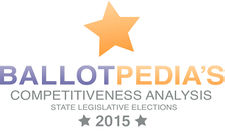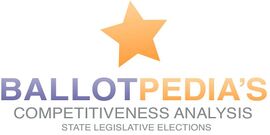Following an even-year election cycle which was statistically the worst since Ballotpedia began yearly analyses of state legislative electoral competitiveness in 2010, 2015 set a new record not only for off-year election cycles but also in general. While the percentage of open seats was not dissimilar to 2011 and the percentage of incumbents facing primary opposition reached a high mark for odd years, the percentage of general elections between major candidates in the general election was the lowest recorded so far, bringing 2015's Competitiveness Index to a new record low.
| Overall Comparison between years | |||
|---|---|---|---|
| 2011 | 2013 | 2015 | |
| Competitiveness Index | 31.9 | 30.9 | 24.8 |
| % Open Seats | 18.2% | 6.8% | 13.9% |
| % Inc that did face primary | 20.1% | 12.2% | 21.8% |
| % Candidates that did face major party opp | 57.4% | 73.6% | 38.7% |
Of the country's 7,383 state legislative seats, 538 were up for election in the November 2015, state legislative elections. This article is an overview of our analysis of the degree of competitiveness in 2015's state legislative elections. The analysis utilized the 3-factor "Competitiveness Index."
3-factor Competitiveness Index[edit]
- Incumbents in primaries: Incumbents with a primary challenger in the 2015 state legislative elections
- Major party candidates with no competition: Major party candidates with major party competition in the 2015 state legislative elections
- Open seats: Open seats in the 2015 state legislative elections
- Summary chart: State legislatures compared by extent of electoral competitiveness in 2015
Objectives[edit]
- To know which states have the most competitive electoral environment and which states have the least competitive electoral environments in 2015.
- To collect data about the overall competitiveness of the 2015 state legislative elections. In 2010, "when we first started building state-by-state lists of state legislative candidates, we were surprised at the number of seats where there was minimal or no competition. It was especially surprising because many observers on the national level regard 2010 as a highly-competitive election environment." The picture that emerged as we continued our study suggests that this is not the case at the level of state legislative elections, despite a relatively high degree of voter discontent. Our guess is that even many highly-engaged or newly-engaged political activists are unaware of the opportunities that exist for expanded electoral competitiveness at the level of state legislative elections. These observations led us to develop and present an empirical study of this phenomenon.
- To develop a Competitiveness Index to be used in future years, so that political observers can assess the ebb and flow of state legislative election competitiveness over time.
Competitiveness: Open seats[edit]
In 75 (13.9%) of the 538 seats up for election in 2015, there was no incumbent running for re-election, either because he or she voluntarily chose not to run again or was barred by term limits or redistricting.
In 463 (86.1%) of the 538 seats up for election in 2015, the incumbent opted to run for re-election.
Competitiveness: Incumbents in primaries[edit]
A total of 101 incumbents faced a primary challenger in 2015.
Since 463 incumbents ran for re-election in 2015, that means that only 21.8 percent of them faced a primary challenger.
The remaining 362 incumbents (78.2%) that ran for re-election in 2015 had no primary challenger.
Louisiana operates under a "jungle primary" system in which candidates of all party affiliations are grouped together in the same primary election; the top two finishers move on to a second election unless a candidate wins by a majority, in which case he or she is considered elected. For the purpose of this analysis, an incumbent is considered challenged in the primary if he or she has competition from at least one member of the same party, even in situations where the winner is immediately elected. For example, if a primary features a Democratic incumbent and a Republican challenger, this race has the effect of a general election and would not be counted in this analysis.
Competitiveness: Major party candidates with no competition[edit]
There are 1,972 state senators and 5,411 state representatives. As of September 2, 2015, there were only 77 total third-party, independent or nonpartisan legislators out of 7,383 total state legislators. (Of those 77, 49 were Nebraska State Senators, where all candidates must run as nonpartisan.) Thus, a major party candidate is virtually guaranteed election when facing third parties. However, non-major party incumbents are counted as major party candidates in this analysis.
For the purposes of this analysis, Louisiana races featuring candidates of only one party were treated as if one major party candidate ran in a general election, even if a plurality result occurs at the end of the primary, forcing a second election.
- In 85 (64.9%) of the 131 senate seats up for election, there was only one major party candidate running in the general election.
- In 245 (60.2%) of the 407 house seats up for election, there was only one major party candidate running in the general election.
- Given that major party candidates win nearly 100 percent of the time, a candidate running without any major party opposition is essentially assured election -- even if there are third party candidates.
- There was only one major party candidate in 330 (61.3%) of the 538 seats up for election in 2015.
- There was more than one major party candidate in 208 (38.7%) of the 538 seats up for election in 2015.
Methodology[edit]
Primary competitiveness[edit]
Using the official primary candidate lists from each state, staff members analyze each district's race to look for the following circumstances:
- No incumbent running with only one candidate
- No incumbent running with a contested primary
- Incumbent is running uncontested
- Incumbent is running in a contested primary
- No candidate has declared
General election competitiveness[edit]
Using the official candidate lists from each state, staff members analyze each district's race to look for the following circumstances:
- Incumbent is not running
- Only one major party candidate in the general election
See also[edit]
- State legislative elections, 2015
- Competitiveness Index by year: 2014 • 2013 • 2012 • 2011 • 2010
- Comparing the competitiveness index for state legislative elections
| ||||||||||||||||||||||||||||
| |||||||||||



